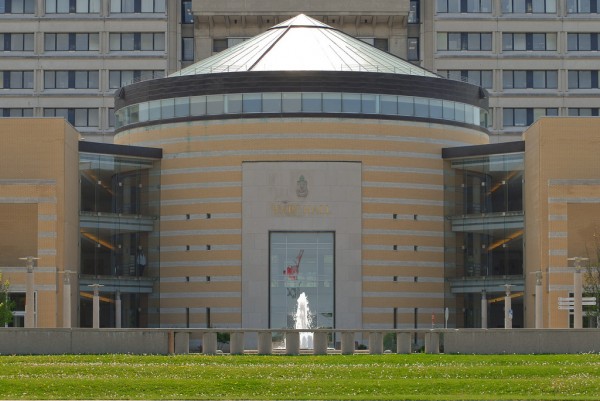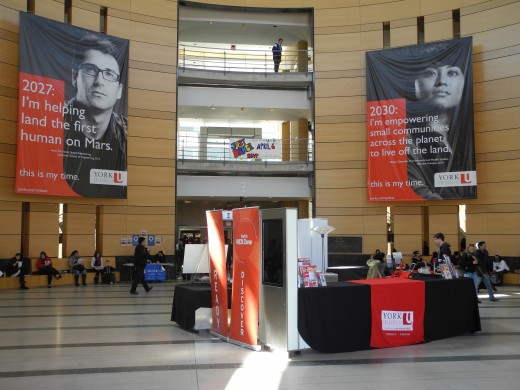by L. Anders Sandberg
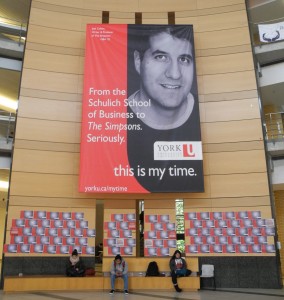
The University's $6million "this is my time" promotion campaign is here contrasted with the 2014 York Federation of Students' 2014 "#thisismydebt" effort protesting tuition fee increases. The display of the smaller posters lists the debts of individual students. University staff removed the posters overnight.
Adorned with yellow brick and two lower rectangular structures extending from its sides, Vari Hall is a well-designed and extraordinary space. When I enter the building I am engulfed by a cylindrical-shaped hall and stories echoing of its outer walls. The building was constructed in 1992 and named after one of York University’s benefactors George Vari (1923-2010)—a Hungarian refugee from the revolution in 1956 who made a fortune in the construction industry—and his wife Helen. Its sleek post-modern design was intended to provide the sprawling suburban campus with a more urban aesthetic, revamping its image as a poor cousin to the University of Toronto. Of the three interconnected buildings, the Rotunda is most eye-catching; it has also been the centre of frequent social and political debates.
Inside the Rotunda, my eyes soar up two storeys and marvel at the maple wood and dark mahogany panels overlooking the beautiful open common space. A few years ago the Rotunda was void of any décor but the University has since added benches and a set of desks, anchored in the floor, which are now used by staff and hired students to welcome new and prospective students to the campus.
I roam the Rotunda and come across a plaque honouring the Varis and a newly minted set of glass displays celebrating faculty members for their achievements. The new display, along with a series of huge “It’s My Time” posters featuring individual students, suggest a growing celebration of the individual rather than collective. In addition to focusing on the individual, this design and marketing approach positions Vari Hall as a spectacular and branded space—a magnet to attract private donors and student tuition fees in an increasingly competitive post-secondary education sector.
Waving at the close-circuit camera, it is clear that the Rotunda is also a centrally controlled space, a private space, where the University administration monitors and disciplines activities that may be disruptive to neighbouring classes but also to its image and reputation. At the same time a statement by Moriyama and Teshima (the firm that designed the building) reads:
“One of the issues explored in the building’s design was how architecture can support and even encourage the learning process. In Vari Hall, learning spills out into stairways, corridors, under stairs, wherever students can gather informally and spontaneously to discuss and debate.”
Indeed, these words foreshadow the ways in which students and faculty members have engaged with the space since its opening, and their insistence that demonstrations in the area are not disruptive to the university’s day to day operations.
The open and accessible design of the space, central location and spirit of the students has created a backdrop for spectacle and social debates, which have been covered by mainstream media, and also, contested the space as “private” and “institutional”. Since its opening, demonstrations, exhibitions, theatre performances, and university fairs, not always sanctioned by the University, have been a common feature in the Rotunda.
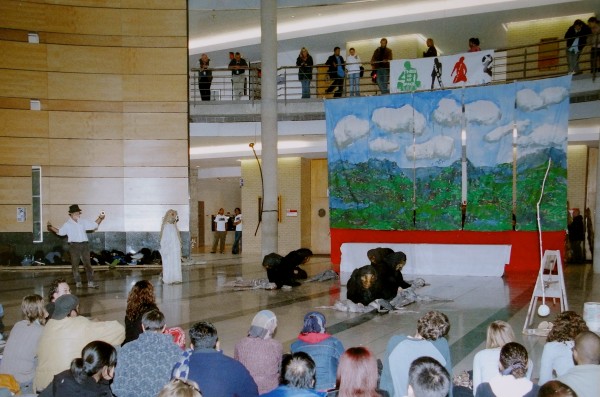
The Bread and Puppet Theater group from Vermont performed at Vari Hall on November 8, 2005. The group was invited by the York Federation of Students in its fight “for more student space on increasingly corporatized Canadian University campuses.” The posters attached to the railing on the second floor level read “This is my space.” Photo courtesy Deborah Barndt
In fact, at the inauguration of the Hall, with a table of dignitaries present, a group of students crashed the party, helped themselves to the food and drink, and protested pending tuition fee hikes. On another “by invitation only” event, welcoming Seneca College to the campus, students once again converged upon the space and protested tuition fee increases. They took over the upper galleries - out of the reach of campus security - shouting and lowering a picture of the then premier Mike Harris with a great clown nose. Later I read an account of a bystander who noted that the space was impossible to control and mused that anyone who grew up through the student protest movement of the 1960s would think that the whole thing was “kind of neat”.
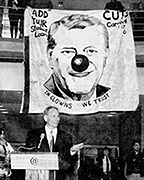
Minister Of Education John Snobelen faced student protests in Vari Hall on October 8, 1996. The image is of premier Mike Harris and the text underneath his face reads “In Clowns We Trust.”
However, some of the stories that have unfolded in the Rotunda are more antagonistic and complicated than “neat”.
As one of the most culturally diverse campuses in the country, the University prides itself on inclusion and the embrace of varied perspectives. However, on occasion, these perspectives clash, as was the case with the heated and high profile confrontation between pro-Israeli and pro-Palestinian student groups. Characterized by Toronto Life Magazine as “York’s Middle Eastern War”, this story, or perhaps more accurately stories, unfolded in the center of Vari Hall. In early 2003, following a visit from Daniel Pipes, a polarizing public figure who tracks what he deems to be anti-Israel sentiment through his website Campus Watch, things began to heat up. During a particularly raucous anti-war demonstration, the police was called. Police officers claimed protesters assaulted them, protesters countered that police beat them, arrests were made and York’s beautifully designed space and overall public profile were tainted by political spectacle and conflict.
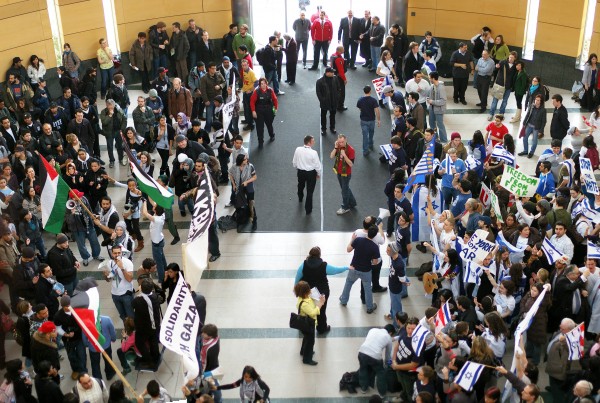
Shot from the Gaza rally at York University. Gaza supporters on the left, Israel supporters on the right. Photo by Tom Cochrane, some rights reserved.
Looking down at students now peacefully lounging on benches it is difficult to comprehend the immense tension and contrasting visions of the Rotunda. The multi-layered space and its circular shape have helped define and facilitate ceremonies, protests and performances. Likely, due to some of the challenges associated with the space, in 2009, the University Administration announced that Vari Hall would be transformed into a more accommodating space to students. “The kinds of possible uses,” it proposed, "could include a student lounge(s), food service(s), cultural displays, information services, or a forum for debate and dialogue.” Three development scenarios were presented without any consideration of leaving the Hall as the architects envisioned it in the first place. Many students reacted negatively to these proposals, seeing them as a thinly veiled attempt to control the space through physical modifications rather than overt administrative regulations. They therefore saw the proposals as a pick between “an unusable lounge, a corporate looking kiosk … or a badly designed night club … transforming student democratic space into a privatized eyesore.”
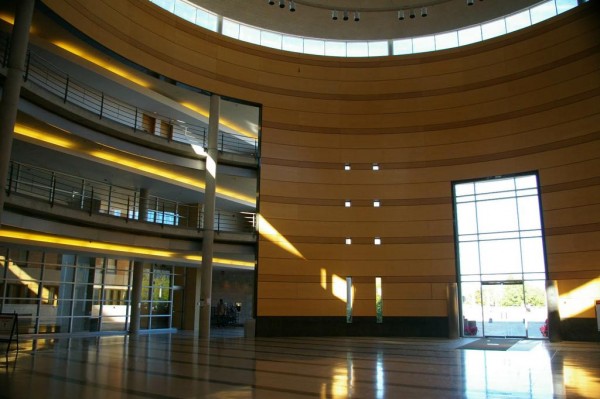
The old Vari Hall illustrates the architect’s concept of a monumental emptiness, an emptiness for people to fill in a spontaneous way. Is this idea threatened by the furniture, desks and displays in the rotunda? Photo by Brent Zimmerman, some rights reserved.
And so the contestation over Vari Hall continues. What do you think? Should Vari Hall be a public space with open access? Or is it private space subject to University rules and regulations? Who should take part in planning a university space such as Vari Hall? To what extent does and can architecture encourage and inhibit certain activities in a space? Is architecture political?
Sources:
- Brulé, Elizabeth, 2015. "Voices from the Margins: The Regulation of Student Activism in the New Corporate University." Studies in Social Justice 9, 2, 159-175.
- Ferguson, Robert, 2009. Campus Friction: A Short Ethnographic Engagement with Protest as Performance in York University’s Vari Hall.
- Keep Vari Hall as It Is—Real Student Space, 2010. Accessed 23 May.
- O’Connor, Claire, 2009. “Pedagogies of Space: The Contestation of Vari Hall.” Master of Arts in Communication and Culture. Research Paper. Toronto: York University.
- No author, 2005. “York Condemned for Use of Police Force at Rally,” CAUT Bulletin, February, A11, A1.
- Rodman, Margaret, Patti Hall Hawkins and Daniel Teramura, 1998. “It’s Not Over: Vari Hall as Contested Academic Space at York University.” Canadian Journal of Urban Research 7, 1 (June), 47-71.
- Rights and Responsibilities within the University: Report of the Presidential Task force on Student Life, Learning & Community. 2009.
- YUFA, 2005. Were Classes and Exams Disrupted in Vari Hall on 20 January? YUFA Members Respond.

This work is licensed under a Creative Commons Attribution-ShareAlike 3.0 Unported License.



